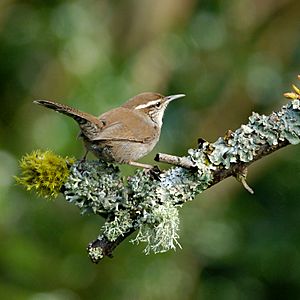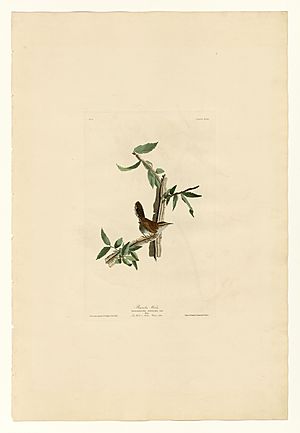Bewick's wren facts for kids
Quick facts for kids Bewick's wren |
|
|---|---|
 |
|
| Conservation status | |
| Scientific classification | |
| Genus: |
Thryomanes
|
| Species: |
bewickii
|
| Subspecies | |
|
1–2 dozen living, 2 recently extinct; see article text |
|
 |
|
| Synonyms | |
|
|
The Bewick's wren (Thryomanes bewickii) is a small wren bird. It lives in North America. It's about 14 cm (5.5 in) long. This bird has grey-brown feathers on its back and white feathers underneath. It also has a long white stripe above its eye, like an eyebrow.
The Bewick's wren looks a bit like the Carolina wren. But you can tell them apart by the Bewick's wren's long tail, which has white tips. Its song is loud and beautiful, similar to other wrens. You can often find these birds in bushy areas, piles of branches, and open woods. They like scrubby places, especially near streams. They mostly eat insects and spiders. They find their food on plants or on the ground.
Historically, these wrens lived from southern British Columbia to Mexico. They were also found in states like Nebraska, Maryland, and Arkansas. However, today they are very rare east of the Mississippi River.
Contents
About the Bewick's Wren
The Bewick's wren is about 13 cm (5.1 inches) long. It weighs around 8 to 12 grams (0.3 to 0.4 ounces). Its wingspan is about 18 cm (7 inches). The bird has brown feathers on its back and light grey feathers on its belly. A white stripe above each eye makes it easy to spot.
Its beak is long, thin, and slightly curved. The most special thing about this wren is its long tail. It has black bars and white corners. The bird moves its tail a lot, which helps you notice it. Young Bewick's wrens look much like the adults. Their beaks might be shorter. Also, their bellies might have faint spots. Male and female wrens look very similar.
What Does it Sound Like?

Bewick's wrens are very noisy birds, like many other wrens. Both male and female wrens make short calls when they are looking for food. They also make a harsh, scolding sound if they feel bothered or upset.
Male wrens sing to attract a mate and to protect their home area. Their song has two or three parts. One male can have up to 22 different versions of its song! They can even make their voice sound far away, like ventriloquism. A male wren learns its song from other male wrens nearby. So, its song will be different from its father's song.
Birds from different areas can sound different. Wrens on the Pacific Coast sing more complex songs. Wrens in the Southwest have simpler songs. Wrens in the eastern parts of the country were also known for their beautiful singing.
Where Bewick's Wrens Live
The Bewick's wren used to live across much of the United States, Mexico, and parts of Canada. It was once common in the Midwest and the Appalachian Mountains. But now, it is very rare east of the Mississippi River.
You can still find them along the Pacific Coast. This includes areas from Baja California to British Columbia. They also live in Mexico and many parts of the Southwestern United States. This includes Texas, Arizona, New Mexico, and Oklahoma. Wrens in the western areas usually do not move far. Eastern wrens used to fly south for winter, but they are now mostly gone.
Bewick's wrens prefer dry, open woodlands and bushy areas. They like hillsides and uplands. Sometimes they live in humid places too. They are more common than house wrens in dry habitats. In California, they live in a shrubland area called chaparral.
How Bewick's Wrens Behave
What They Eat
Bewick's wrens are insect eaters. They pick insects and their eggs off plants. They also find food on tree trunks. They usually don't look for food higher than 3 meters (10 feet). But they will also search for food on the ground.
These wrens can hang upside down to catch insects. For example, they might grab an insect from the bottom of a branch. When they catch an insect, they kill it before swallowing it whole. After eating, Bewick's wrens often wipe their beaks on their perch.
Bewick's wrens sometimes visit backyard bird feeders. They will eat suet, peanut hearts, sunflower seeds, and mealworms. In winter, like many insect-eating birds, they also eat seeds.
How They Raise Their Young
Courtship starts with the male singing from a high spot. He might stop singing to chase away other male wrens. Bewick's wrens form pairs and stay together for breeding. The male starts building the nest in a hole or birdhouse. The female joins him later.
They build their nest from twigs and other plant materials. They often line it with soft feathers. The nest is shaped like a cup. It is usually hidden in a nook or cavity. The female lays 5 to 7 white eggs with brown spots. Bewick's wrens usually have two groups of babies each year. Pairs stay together for breeding. But they live alone during the winter.
Protecting Bewick's Wrens
In 2016, the Bewick's wren was listed as "least concern" by the IUCN Red List. This means it's not in immediate danger globally. This is because of its wide range and large population size. However, bird experts have noticed a big drop in their numbers. This is especially true in their eastern range and some western areas. They have almost disappeared from east of the Mississippi River.
In 1984, the state of Maryland listed the Bewick's wren as "endangered." This means it was at risk of disappearing from the state. But even with this, no breeding pairs are known to be left in Maryland. In 2014, a bird conservation group put the eastern Bewick's wren on its "watch list."
Scientists have a few ideas why they are disappearing in the east. One idea is the use of pesticides. Another is competition from other bird species. The most likely reason seems to be competition from house wrens. House wrens look for the same nesting spots as Bewick's wrens. House wrens will even destroy the nests and eggs of Bewick's wrens. Also, when open land becomes forests again, it hurts the eastern Bewick's wrens.
In California, building new homes and businesses has caused habitat loss. This has affected the Bewick's wren. In San Diego, building in canyons has led to fewer native birds, including the Bewick's wren.
However, in Washington, new development has actually helped the Bewick's wren population grow. But this has also led to fewer Pacific wrens because of more competition between the two species.
- Interactive range map of Thryomanes bewickii at IUCN Red List maps
- Audio recordings of Bewick's wren on Xeno-canto.
See also
 In Spanish: Reyezuelo de Bewick para niños
In Spanish: Reyezuelo de Bewick para niños



